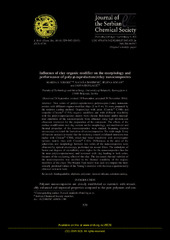Приказ основних података о документу
Influence of clay organic modifier on the morphology and performance of poly(epsilon-caprolactone)/clay nanocomposites
| dc.creator | Nikolić, Marija | |
| dc.creator | Đorđević, Nataša | |
| dc.creator | Rogan, Jelena | |
| dc.creator | Đonlagić, Jasna | |
| dc.date.accessioned | 2021-03-10T12:45:01Z | |
| dc.date.available | 2021-03-10T12:45:01Z | |
| dc.date.issued | 2015 | |
| dc.identifier.issn | 0352-5139 | |
| dc.identifier.uri | http://TechnoRep.tmf.bg.ac.rs/handle/123456789/2988 | |
| dc.description.abstract | Two series of poly(epsilon-caprolactone) poly(oxepan-2-one) nanocomposites with different organo-modified clays (1 to 8 wt. %) were prepared by the solution casting method. Organoclays with polar (Cloisite (R) C30B) and nonpolar (Cloisite (R) C 15A) organic modifiers and with different miscibility with the poly(epsilon-caprolactone) matrix were chosen. Exfoliated and/or intercalated structures of the nanocomposite were obtained using high dilution and ultrasonic treatment for the preparation of the composite. The effects of the surface modification and clay content on the morphology, and mechanical and thermal properties of the nanocomposites were studied. Scanning electron microscopy excluded the formation of microcomposites. The wide-angle X-ray diffraction analysis revealed that the tendency toward exfoliated structures was higher with Cloisite (R) C30B, which had better miscibility with poly(epsilon-caprolactone) matrix, than with Cloisite (R) Cl 5A. Differences in the sizes of the spherulites and morphology between two series of the nanocomposites were observed by optical microscopy performed on as-cast films. The enthalpies of fusion and degrees of crystallinity were higher for the nanocomposites than for the neat poly(epsilon-caprolactone) and increased with clay loading in both series, because of the nucleating effect of the clay. The decreased thermal stability of the nanocomposites was ascribed to the thermal instability of the organic modifiers of the clays. The Halpin-Tsai model was used to compare the theoretically predicted values of the Young's modulus with the ones experimentally obtained in tensile tests. | en |
| dc.publisher | Srpsko hemijsko društvo, Beograd | |
| dc.relation | info:eu-repo/grantAgreement/MESTD/Basic Research (BR or ON)/172062/RS// | |
| dc.rights | openAccess | |
| dc.rights.uri | https://creativecommons.org/licenses/by-nc-nd/4.0/ | |
| dc.source | Journal of the Serbian Chemical Society | |
| dc.subject | biodegradable | en |
| dc.subject | aliphatic polyester | en |
| dc.subject | layered silicate | en |
| dc.subject | solution casting | en |
| dc.title | Influence of clay organic modifier on the morphology and performance of poly(epsilon-caprolactone)/clay nanocomposites | en |
| dc.type | article | |
| dc.rights.license | BY-NC-ND | |
| dc.citation.epage | 547 | |
| dc.citation.issue | 4 | |
| dc.citation.other | 80(4): 529-547 | |
| dc.citation.rank | M23 | |
| dc.citation.spage | 529 | |
| dc.citation.volume | 80 | |
| dc.identifier.doi | 10.2298/JSC140924119N | |
| dc.identifier.fulltext | http://TechnoRep.tmf.bg.ac.rs/bitstream/id/9382/0352-51391500119N.pdf | |
| dc.identifier.scopus | 2-s2.0-84934876360 | |
| dc.identifier.wos | 000354829100009 | |
| dc.type.version | publishedVersion |

